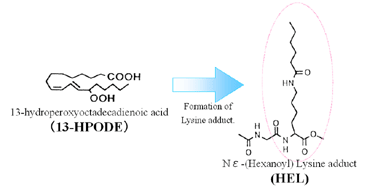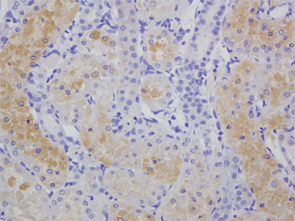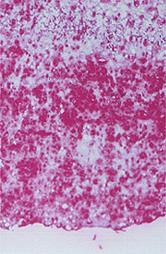 |
Oxidative Stress
Rev.120209 |
Anti Hexanoyl-lysine adduct antibody
(Anti HEL monoclonal antibody) |
|
| A new biomarker for lipid peroxidation |
 |
Oxidative damage of lipids caused by reactive oxygen species (ROS) play an important role in some
diseases, lesion of cell functions and aging. Aldehydes such as malondi-aldehyde (MDA) and 4-hydroxy-2-nonenal (4-HNE) have been reported
as one of the advanced lipid peroxidation products. But recently in the earlier stage of lipid peroxidation, 13-hydroperoxyoctadecanoic
acid (13-HPODE) is found to be covalently bound to proteins1). Hexanoyl-Lysine adduct (HEL) is a novel lipid hydroperoxide-modified lysine
residues. HEL is formed by oxidative modification by oxidized omega-6 fatty acids such as linoleic acid or arachidonic acid.
This monoclonal antibody (clone 5H4)is spesific for proteins and peptides containing HEL. Suitable for HEL detection by immunohistochemistry
and western blotting.
|
|

Cisplatin-treated rat kidney.
(Dr. Sugiyama, Tottori Univ.) |

Detection of HEL at Human atherosclerotic lesions.
(Dr. Naito) |
|
| Product name |
Code |
Specifications |
Application |
NOTICE |
| Anti HEL antibody(clone 5F12) |
MHL-021P |
20 µg of IgG |
IHC |
Current product |
| Anti HEL antibody(clone 5H4) |
MHL-020P |
20 µg of IgG |
IHC |
Discontinued |
|
Made in Japan.
IMPORTANT NOTICE
The clone of anti HEL monoclonal antibody has been changed from 5H4 (code. MHL-020P) to 5F12
(code. MHL-021P). If you need old product, please contact our technical support.
|
|
|
| FOR RESEARCH USE ONLY. Not for diagnostic, medical or other use. |
| Clone #: |
5F12 |
| Subclass: |
IgG1 kappa |
| Antigen: |
N epsilon hexanoyl-Keyhole limpet hemocyanin (HEL-KLH) |
| Specificity: |
Specific to Hexanoyl-Lys adducts. |
| Form: |
Lyophilized power. Containing 10mM PBS(pH7.4), 5% sucrose, 1% BSA and 0.05% Procline 950.
100 µg/mL of IgG. |
| Application: |
Immunohistochemistry
(Recommended antibody concentration is 2 µg/mL on paraformaldehyde fixed tissue), and ELISA |
| Storage: |
Less than -20°C |
|
| Fixation: |
Formalin fixation. Slides should be prepared 3 um thick.
Antigen retrieval is not needed, but in some cases antigen retrieval may improve staining. |
| Blocking: |
Apply normal rabbit serum (DAKO corporation, Kyoto, Japan) in 1% BSA/PBS for 30 minites
to the specimens for the inhibition of non-specific binding of secondary antibody.
For blocking reagent, please use normal serum from the same species as second antibody used.
For example, if you use biotin-labeled goat anti mouse IgG, normal goat serum may be suitable.
If sample tissues are from mouse, blocking of internal mouse IgG will be needed. See technical information. |
| Anti HEL antibody: |
Apply anti HEL antibody (2 µg/mL) to the specimens, incubate overnight
at 4 °C. |
| Secondary antibody: |
Apply biotin-labeled rabbit anti-mouse IgG serum (Dako; Diluted to 1:300) for 40min
at room temperature. |
| ABC method: |
Apply avidin-biotin-alkaline phosphatase complex (Vector Lab., Burlingame, CA;
Diluted to 1:100) for 40min at room temperature. |
| Staining: |
Use a kit of black substrate for alkaline phosphatase (BCIP/NBT, Vector). |
|
|
| 1) |
Yoji Kato, Yoko Mori, Yuko Makino, Yasujiro Morimitsu, Sadayuki Hiroi, Toshitsugu Ishikawa,
Toshihiko Osawa, Formation of N epsilon-(hexanonyl) lysine in protein exposed to lipid hydroperoxide.
J Biol Chem 274(29), p20406-20414 (1999)
Identification of HEL, which is lysine adduct of 13-HPODE. |
| 2) |
Kato Y, Miyake Y, Yamamoto K, Shimomura Y, Ochi H, Mori Y, Osawa T,
Preparation of a monoclonal antibody to N(epsilon)-(Hexanonyl)lysine: application to the evaluation of protective effects
of flavonoid supplementation against exercise-induced oxidative stress in rat skeletal muscle.
Biochem Biophys Res Commun 274(2),p389-393(2000)
Development and characterization of anti HEL monoclonal antibody. |
| 3) |
Fukuchi Y, Miura Y, Nabeno Y, Kato Y, Osawa T, Naito M,
Immunohistochemical detection of oxidative stress biomarkers, dityrosine and N(epsilon)-(hexanoyl)lysine, and C-reactive protein
in rabbit atherosclerotic lesions. J Atheroscler Thromb 15(4)p185-192(2008)
Application to rabbit atherosclerotic lesions. |
| 4) |
Maeda R, Noiri E, Isobe H, Homma T, Tanaka T, Negishi K, Doi K, Fujita T, Nakamura E,
A water-soluble fullerene vesicle alleviates angiotensin II-induced oxidative stress in human umbilical venous endothelial cells.
Hypertens Res 31(1)p141-151(2008)
Application to cultured cells (HUVECs). |
| 5) |
Sango K, Yanagisawa H, Kato K, Kato N, Hirooka H, Watabe K:
Differential Effects of High Glucose and Methylglyoxal on Viability and Polyol Metabolism in Immortalized Adult Mouse Schwann Cells.
Open Diabetes J. 1, p1-11(2008)
Application to cultured cell from mouse. |
|
| FOR RESEARCH USE ONLY. Not for diagnostic, medical or other use. |
|


